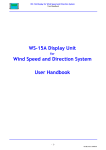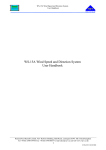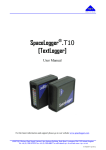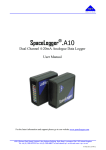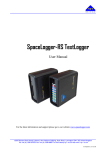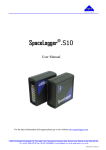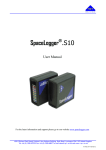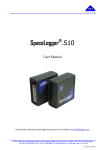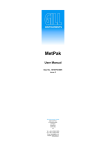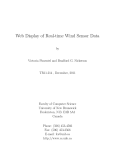Download SpaceLogger-RS WindLogger User Manual
Transcript
SpaceLogger-RS WindLogger User Manual For the latest information and support please go to our website www.spacelogger.com ©2008 Richard Paul Russell Limited, New Harbour Building, Bath Road, Lymington SO41 3SE United Kingdom Tel +44 (0) 1590 679755 Fax +44 (0) 1590 688577 e-mail [email protected] web www.r-p-r.co.uk 017SL025/2 02/01/08 SpaceLogger-RS™ WindLogger User Manual 1. INTRODUCTION....................................................................................................................2 2. QUICK START: EASY STEPS TO WIND DATA LOGGING..........................................3 3. EXAMPLE APPLICATIONS.................................................................................................3 4. CONNECTING........................................................................................................................4 4.1 Terminal Strip Arrangement..................................................................................................4 4.2 Generic Terminal Allocations................................................................................................4 4.3 RS232 Interface......................................................................................................................5 4.4 Logging Interval Selection.....................................................................................................5 4.5 Cable Preparation...................................................................................................................6 4.6 Power Supply.........................................................................................................................6 4.7 Baud Rate Selection...............................................................................................................7 4.8 Use With Other Sensors.........................................................................................................7 5. LOGGING................................................................................................................................9 5.1 Setting the Time and Date......................................................................................................9 5.2 MMC mobile Card...............................................................................................................10 5.3 Data Transfer........................................................................................................................10 5.4 Data Storage.........................................................................................................................11 6. SPACELOGGER-RS WINDLOGGER SPECIFICATION..............................................12 6.1 PHYSICAL..........................................................................................................................12 6.2 ENVIRONMENTAL...........................................................................................................12 6.3 POWER................................................................................................................................12 6.4 I/O CAPABILITY...............................................................................................................12 6.5 DATA STORAGE...............................................................................................................13 6.6 AUDIO/VISUAL INDICATORS........................................................................................13 6.7 REAL-TIME CLOCK..........................................................................................................13 APPENDICES................................................................................................................................14 A1 Guarantee.............................................................................................................................14 A2 Electromagnetic Conformity................................................................................................15 A3 WEEE (Waste, Electrical and Electronic Equipment) Statement........................................16 A4 RoHS Statement...................................................................................................................16 ©2008 Richard Paul Russell Limited, New Harbour Building, Bath Road, Lymington SO41 3SE United Kingdom Tel +44 (0) 1590 679755 Fax +44 (0) 1590 688577 e-mail [email protected] web www.r-p-r.co.uk 1 017SL025/2 02/01/08 SpaceLogger-RS™ WindLogger User Manual 1. INTRODUCTION SpaceLogger-RS WindLogger is designed for real-time wind speed and direction data logging. It receives data via RS232 from Gill Instruments’ WindSonic ultrasonic wind sensors and other compatible sensors. Each data record is date and time-stamped when it is stored. A new file (.CSV) is generated for each day’s worth of data. Data is stored onto an MMC mobile card. MMC mobile cards with up to 2 GByte capacity are compatible with SpaceLogger-RS. Higher capacity cards are not compatible. SpaceLogger-RS will also accept other compatible data storage cards, such as full size MMC and some SD cards. The MMC mobile card can be removed from the logger and inserted into a card reader connected to a PC. Stored data files are accessed in the same way as files on the computer's other disk drives. The files may be read and manipulated in any standard spreadsheet program (e.g. MS Excel, OpenOffice.org calc). The logger requires a 7 - 30 volt DC supply which can be provided by an AC/DC mains adaptor or suitable battery. Alternatively, where a WS15A Display is used, power may be provided directly from the display unit. Document revision summary Issue 1 2 Date Nov 2007 2 Jan 2008 Description Original document General revision Our products are in continuous development and therefore specifications may be subject to change and design improvements may be implemented without prior notice. Please visit our web site www.r-p-r.co.uk for the most up to date information on our products. ©2008 Richard Paul Russell Limited, New Harbour Building, Bath Road, Lymington SO41 3SE United Kingdom Tel +44 (0) 1590 679755 Fax +44 (0) 1590 688577 e-mail [email protected] web www.r-p-r.co.uk 2 017SL025/2 02/01/08 SpaceLogger-RS™ WindLogger User Manual 2. QUICK START: EASY STEPS TO WIND DATA LOGGING ..............Connect RS232 inputs ..............Select logging interval ..............Select baud rate ..............Power on ..............Set time and date ..............Insert MMC mobile card ..............Start recording data see section 4.3 see section 4.4 see section 4.7 see section 4.6 see section 5.1 see section 5.2 see section 5.3 ..............Stop recording data ..............Remove card and transfer to PC to view and analyse data see section 5.3 see section 5.3 ............... 3. EXAMPLE APPLICATIONS WindSonic Sensor WindLogger Manual transfer of MMC mobile card to PC card reader Figure 1 WindSonic Sensor Display Unit WindLogger Manual transfer of MMC mobile card to PC card reader Figure 2 ©2008 Richard Paul Russell Limited, New Harbour Building, Bath Road, Lymington SO41 3SE United Kingdom Tel +44 (0) 1590 679755 Fax +44 (0) 1590 688577 e-mail [email protected] web www.r-p-r.co.uk 3 017SL025/2 02/01/08 SpaceLogger-RS™ WindLogger User Manual 4. CONNECTING 4.1 Terminal Strip Arrangement POWER 1 2 3 4 5 6 7 8 9 10 11 12 13 14 15 16 Figure 3 4.2 Generic Terminal Allocations SpaceLogger-RS Terminal 1 2 3 4 5 6 7 8 9 10 11 12 13 14 15 16 Signal description Power GND Supply +V (+7 to 30V dc) Analogue GND 1 Analogue input 1 Analogue GND 2 Analogue input 2 Logging interval selection Logging interval selection Logging interval selection Logging interval selection GND RS232 Tx 2 RS232 Rx 2 RS232 Tx 2 RS232 input 1 RS232 GND 1 Use Power Reserved for future options Digital I/O GND 1 Digital I/O input 1 Digital I/O GND 2 Digital I/O input 2 Logging Interval (see section 4.4) Reserved for future options RS232 signal input from wind sensor Table 1 ©2008 Richard Paul Russell Limited, New Harbour Building, Bath Road, Lymington SO41 3SE United Kingdom Tel +44 (0) 1590 679755 Fax +44 (0) 1590 688577 e-mail [email protected] web www.r-p-r.co.uk 4 017SL025/2 02/01/08 SpaceLogger-RS™ WindLogger User Manual 4.3 RS232 Interface RS232 connection to the wind sensor (or WS15A display unit) should be made as per Table 1. This table should be read in conjunction with Figure 3. Wires should be prepared as per section 4.5. For Gill Instruments’ WindSonic sensors, the following table describes the connections required: WindLogger terminal RS232 input 1 15 WindSonic connection RS232 GND 1 16 Pin 5 TXD Pin 1 Signal GND Table 2 Note that the WindLogger will only receive RS232 input, so when a WindSonic Sensor 2 or 3 is used, it should be configured for RS232 output. Alternatively, when RS485 output is required from the sensor (for example, where a longer cable run is necessary), a WS15A display or a suitable RS485 to RS232 converter at the WindLogger end must be used. For Richard Paul Russell Ltd’s wind display unit WS15A, the following table describes the connections required. The WindLogger is powered by the display unit in this situation. WindLogger terminal Power GND 1 WS15A terminal 25 Power GND 2 Supply +V 26 +V Supply Output 15 RS232 input 1 28 RS232 Tx Output Table 3 The connections should be made with the power to the display unit switched off. For more details on wiring the WS15A display please refer to the WS15A User Manual. 4.4 Logging Interval Selection The default logging interval is equal to the WindSonic sample rate. Please refer to the WindSonic user manual for information on changing the rate between the available 1, 2 and 4 times per second. If a less frequent logging interval is required, the WindLogger may be set to one reading per 2, 5 or 10 seconds by linking terminals as per Figure 4 and Table 4 below. Terminal linking for logging interval selection - example POWER 1 2 3 4 5 6 7 8 9 10 11 12 13 14 15 16 Figure 4 ©2008 Richard Paul Russell Limited, New Harbour Building, Bath Road, Lymington SO41 3SE United Kingdom Tel +44 (0) 1590 679755 Fax +44 (0) 1590 688577 e-mail [email protected] web www.r-p-r.co.uk 5 017SL025/2 02/01/08 SpaceLogger-RS™ WindLogger User Manual Logging Interval Terminals to link As per WindSonic setting None Once every 2 seconds 7 and 8 Once every 5 seconds 9 and 10 Once every 10 seconds 7 and 8 plus 9 and 10 Table 4 4.5 Cable Preparation The logger uses screwless terminals and to ease connection, wires should be prepared as per Figure 5. It is important that the stripped ends be accurately 9 to 10mm long to ensure good connections in the terminals. 9 to 10mm Tinned end Figure 5 Either solid or stranded cable is acceptable, in the range 0.32 to 0.65 mm diameter (AWG 28 to 22) with gauge 24 being ideal. Using a small flat headed screw-driver fully depress the grey plunger for the required terminal and insert the wire as far as it will go, into the hole below the plunger. Release the grey plunger and the wire is held captive by the connector. A gentle tug on the wire will confirm that it is held firmly. If the wire in question is multi-strand, ensure that all strands are inserted in the terminal hole. Please note that interconnection of all components should be completed prior to applying power. 4.6 Power Supply When the logger is powered using a 7 to 30 V DC supply the central pin on the power socket should be to GND. Alternatively, power may be supplied via terminals 1 (black) and 2 (red) on the screwless terminal connector strip, as per Table 1. Note that if power is supplied via the supply socket then terminal 2 (red) is automatically disconnected. Warning: All GNDs are common and so damage to the logger may result if they are connected to different voltages. ©2008 Richard Paul Russell Limited, New Harbour Building, Bath Road, Lymington SO41 3SE United Kingdom Tel +44 (0) 1590 679755 Fax +44 (0) 1590 688577 e-mail [email protected] web www.r-p-r.co.uk 6 017SL025/2 02/01/08 SpaceLogger-RS™ WindLogger User Manual 4.7 Baud Rate Selection The default baud rate is 9600 bits per second. If an alternative baud rate is required the following steps must be followed: 1. Insert MMC mobile card into card reader attached to USB port of PC (or use integrated card reader if the PC has one). 2. Open notepad or similar text editor and type the following line: BAUD=b Where b is the baud rate. Valid baud rates are 115200, 57600, 38400, 19200, 9600, 4800, 2400, 1200, 300 and 110 bits per second. 3. Save this text file as SETUP.TXT on the MMC mobile card in the root folder. 4. Remove card from card reader and insert the card into the WindLogger. 5. The baud rate will now be set to the specified value. For the baud rate to remain set to this value, the file SETUP.TXT must remain on the MMC mobile card in the root directory. If the WindLogger does not find the file SETUP.TXT with a valid baud rate specified, the baud rate will return to the default setting of 9600 Baud. 6. To intentionally return the baud rate to the default setting, delete the file SETUP.TXT from the memory card. 4.8 Use With Other Sensors The WindLogger is capable of being used with other sensors that output their information in ASCII sentences. The format of the data must be 8 bits and no parity. It is also a requirement that each data record has an identifying start character and a different identifying end character. The WindLogger only records the ASCII characters between these start and end characters. The WindSonic’s start character is <STX> (2) and end character is <LF> (10). To set the WindLogger to recognise any other start and end characters the following steps must be followed: 1. Insert MMC mobile card into card reader attached to USB port of PC (or use integrated card reader if the PC has one). 2. Open notepad or similar text editor and type the following line: STX=s ETX=e Where: ©2008 Richard Paul Russell Limited, New Harbour Building, Bath Road, Lymington SO41 3SE United Kingdom Tel +44 (0) 1590 679755 Fax +44 (0) 1590 688577 e-mail [email protected] web www.r-p-r.co.uk 7 017SL025/2 02/01/08 SpaceLogger-RS™ WindLogger User Manual s is the decimal value of the ASCII character that indicates the start of the data string that is to be stored. This character is replaced by the date and time when the data is logged. Default value is 2. And, e is decimal value of the ASCII character that indicates the end of the data string that is to be stored. Default value 10. 3. Save this text file as SETUP.TXT on the MMC mobile card in the root folder. 4. Remove card from card reader and insert the card into the WindLogger. 5. The start and end characters that the WindLogger will now look for when storing data will now be set to the desired values. 6. To return the start and end characters to the default settings, delete the file SETUP.TXT from the card. Note: if it is necessary to modify both the baud rate and start and end characters, the file SETUP.TXT should contain the three lines: BAUD=b STX=s ETX=e ©2008 Richard Paul Russell Limited, New Harbour Building, Bath Road, Lymington SO41 3SE United Kingdom Tel +44 (0) 1590 679755 Fax +44 (0) 1590 688577 e-mail [email protected] web www.r-p-r.co.uk 8 017SL025/2 02/01/08 SpaceLogger-RS™ WindLogger User Manual 5. LOGGING Red LED: Data writing to card Green LED: Ready to Record Data Time & Date Set, Stop Recording & Buffer Purge Button Card Slot with MMC mobile card inserted Figure 6 5.1 Setting the Time and Date To set the time and date for correct stamping of the data records, a file named AUTO.TXT must be created on the memory card. This file is read by the WindLogger when the card is inserted into the logger and the clock synchronised to the given time when the button to the left of the card slot is pressed. Steps to set the time and date: 1. Insert MMC mobile card into card reader attached to USB port of PC (or use integrated card reader if the PC has one). 2. Open notepad or similar text editor and type the following three lines: WAIT TIME=hh:mm:ss DATE=DD/MM/YYYY Where hh:mm:ss is the time in, say, a couple of minutes and DD/MM/YYYY is today’s date. 3. Save this text file as AUTO.TXT on the MMC mobile card in the root folder. 4. Remove card from card reader and, with the power on, insert the card into the WindLogger. Both the red and green LEDs will come on. ©2008 Richard Paul Russell Limited, New Harbour Building, Bath Road, Lymington SO41 3SE United Kingdom Tel +44 (0) 1590 679755 Fax +44 (0) 1590 688577 e-mail [email protected] web www.r-p-r.co.uk 9 017SL025/2 02/01/08 SpaceLogger-RS™ WindLogger User Manual 5. At the time saved in the AUTO.TXT file, press the button to the left of the card slot. The WindLogger will ‘Beep’ once and both LED’s switch off. Release the button. The red LED may flicker on and off after this and once the card has completed it’s initialisation the green LED will come back on and remain on. 6. After updating the time and date, the WindLogger renames the file AUTO.TXT to AUTO_OLD.TXT to avoid unintentionally repeating the commands next time the unit is switched on or the card re-inserted. The WindLogger has an internal battery to maintain the time and date when the power to the unit is switched off. When it is necessary to reset the time and date, please repeat the steps outlined above. If no time and date is set up on the WindLogger, the unit will emit a warning ‘Beep’ four times a minute as a reminder. 5.2 MMC mobile Card Once the time and date have been set on the WindLogger, when the MMC mobile card is inserted correctly into the WindLogger (with power supplied), the unit should ‘Beep’ once and the red LED blink as the card initialises. At this stage, the WindLogger’s internal buffer is cleared and is ready to start receiving new data from the connected wind sensor. The length of time the memory card takes to initialise will depend on the formatting of the card and the amount of data already stored on it. After initialisation, the green LED will switch on indicating that the unit is ‘Ready to Record Data’. The green LED will remain on while the unit is in this state. The MMC mobile card is designed to fit easily into the card slot one way only. Do not bend the card or force it into the slot. 5.3 Data Transfer Received data is stored temporarily in a buffer (1024 bytes). The WindLogger replaces the start character of each data record with the current time and date. Data is transferred from the buffer to the MMC mobile card in 512 byte packages. If no data has been received from the data source for a set time period (approximately 4 seconds) then any remaining data in the buffer is written to the MMC mobile card. The red LED blinks each time data is written to the card. The MMC mobile card should not be removed while data is being written to it. To stop recording data, the small button to the left of the card slot on the front of the WindLogger should be depressed. There will be an audio signal to indicate that the button has been pressed. This action will also purge any data in the buffer to the MMC mobile card so the card is ready to be removed from the WindLogger. The green LED will automatically switch off to indicate that the unit is no longer enabled to record further data. The card may then be safely removed. To recommence data logging the power must be cycled or a card re-inserted in order to re-initialise the card. The green LED will again indicate the unit as ‘Ready to Record Data’. ©2008 Richard Paul Russell Limited, New Harbour Building, Bath Road, Lymington SO41 3SE United Kingdom Tel +44 (0) 1590 679755 Fax +44 (0) 1590 688577 e-mail [email protected] web www.r-p-r.co.uk 10 017SL025/2 02/01/08 SpaceLogger-RS™ WindLogger User Manual To avoid losing data or corrupting the card, never remove the card or disconnect the power supply when the red LED is flashing or blinking. 5.4 Data Storage WindLogger creates a folder DATA on the MMC mobile card root folder. Data files are written to this folder. A new file is generated each day. The file name takes the format YYYYMMDD.CSV where YYYYMMDD is that day’s date. Data is stored in comma separated variable format files (.CSV) which may be opened in MS Excel and other spreadsheet programs. These files are also readable in notepad or a similar text editor. NB: If the logging interval is set to once per second or a higher frequency, the resulting file size for a complete 24 hr period will be too great to open, without manipulation, in Excel due to Excel’s limitations on number of rows in a worksheet. When the WindLogger is used with WindSonic sensors, data is stored in the following format: DD/MM/YY,hh:mm:ss,Q,ddd,SSS.SS,U,AA, CC Where: DD/MM/YY is the date hh:mm:ss is the time Q is the WindSonic sensor identifier ddd is the is the wind direction from the sensor SSS.SS is the wind speed U is the wind speed units M = m/s, N = knots, P = mph, K = km per hour, F = ft per min AA is the sensor status 00 = OK, 01 = axis failed, 02 = axis 2 failed, 04 = axis 1 and 2 failed, 08 = NVM error, 09 = ROM error CC is the checksum EXCLUSIVE-OR of the bytes between (and not including) the time and the space character before CC as a two character hexadecimal value When logging from a WindSonic sensor, each data reading comprises up to 41 bytes. The following table gives the approximate capacity of various sized memory cards, depending on the logging interval selected, assuming a WindSonic sensor is connected. Memory Card Size 128 MB 512 MB 1 GB 2 GB WindSonic Logging Interval (Readings per time interval) 4 per sec 2 per sec 1 per sec 1 per 2 sec 1 per 5 sec 1 per 10 sec 9 days 18 days 37 days 75 days 189 days 378 days 37 days 75 days 151 days 303 days 757 days >4 years 75 days 151 days 303 days 606 days >4 years >8 years 151 days 303 days 606 days >3 years >8 years >16 years Table 5 ©2008 Richard Paul Russell Limited, New Harbour Building, Bath Road, Lymington SO41 3SE United Kingdom Tel +44 (0) 1590 679755 Fax +44 (0) 1590 688577 e-mail [email protected] web www.r-p-r.co.uk 11 017SL025/2 02/01/08 SpaceLogger-RS™ WindLogger User Manual 6. SPACELOGGER-RS WINDLOGGER SPECIFICATION 6.1 PHYSICAL 6.2 Dimensions: Width: 67 mm Depth: 67 mm Height: 28 mm (excluding optional rubber feet) Weight: 0.075 kg Enclosure material: GP ABS (UL94-HB) plastic and acrylic ENVIRONMENTAL Operating Temperature Range: 6.3 6.4 -25 oC to +70 oC Storage Temperature Range: -40 oC to +70 oC Enclosure protection: IP203 POWER Power requirement: 7 to 30 Vdc Current at 12Vdc: 10 mA typical Supply input protection: Polarity reversal protected and internal fuse – 500 mA slo-blo® (Littelfuse type 0454500 or equivalent) Connection: 1.3 mm centre pin DC connector, or screwless terminals (0.32 to 0.64 mm diameter conductors) I/O CAPABILITY Transmission standard: RS232 compatible, 8 bits and no parity Transmission speed: 9600 Baud (default) or selectable from 115200, 57600, 38400, 19200, 4800, 2400, 1200, 300 or 110 Baud Wire acceptance: 0.32 to 0.65 mm diameter (AWG 28 to 22) ©2008 Richard Paul Russell Limited, New Harbour Building, Bath Road, Lymington SO41 3SE United Kingdom Tel +44 (0) 1590 679755 Fax +44 (0) 1590 688577 e-mail [email protected] web www.r-p-r.co.uk 12 017SL025/2 02/01/08 SpaceLogger-RS™ WindLogger User Manual 6.5 6.6 6.7 DATA STORAGE Data Storage Card: Removable MMC mobile Data Capacity: 2 GByte (max) File System: FAT16 or FAT32 with 8.3 file names Sector size 512 Bytes Data logging interval: Default as per WindSonic setting (1, 2 or 4 readings per sec) or select from 1 reading per 2, 5 or 10 seconds AUDIO/VISUAL INDICATORS LED Indicators: Green: Ready to record data Red: Writing data to MMC mobile card Audio Bleeper: Two tone signal on correct card insertion. Single tone when data purge button depressed. Four bleeps per minute when time & date not set. REAL-TIME CLOCK Accuracy: ±40 ppm at 25°C Backup battery: CR2032 ©2008 Richard Paul Russell Limited, New Harbour Building, Bath Road, Lymington SO41 3SE United Kingdom Tel +44 (0) 1590 679755 Fax +44 (0) 1590 688577 e-mail [email protected] web www.r-p-r.co.uk 13 017SL025/2 02/01/08 SpaceLogger-RS™ WindLogger User Manual APPENDICES A1 Guarantee System components are warranted for a period of twelve (12) months from the original date of purchase, against defective materials and workmanship. In the event that warranty service is required, please contact Richard Paul Russell Ltd. This warranty is only valid if, when warranty service is required, a full description of the fault is provided and presented with the original invoice, and the serial number(s) on the component has not been defaced. Richard Paul Russell Ltd’s liability is limited to items of its own manufacture, and it does not accept liability for any loss resulting from the operation or interpretation of the results from this equipment. This warranty covers none of the following: • • • • • Periodic check ups, maintenance and repair or replacement of parts due to normal wear and tear. Cost relating to transport, removal, or installation of the component. Misuse, including failure to use the component for its normal purpose or incorrect installation. Damage caused by Lightning, Water, Fire, Acts of God, War, Public Disturbances, incorrect supply voltage or any other cause beyond the control of Richard Paul Russell Ltd. Units which have been repaired or units altered by a party other than Richard Paul Russell Ltd’s employees or agents without prior written consent from Richard Paul Russell Ltd. In no event shall Richard Paul Russell Ltd be liable under any circumstances for any direct, indirect or consequential damages, any financial loss or any lost data contained in any product (including any returned product), regardless of the cause of loss. Richard Paul Russell Ltd products are not warranted to operate without failure. Richard Paul Russell Ltd’s products must not be used in life support systems or other application where failure could threaten injury or life. The Customers statutory rights are not affected by this warranty. Unless there is national legislation to the contrary, the rights under this warranty are the customer’s sole rights and Richard Paul Russell Ltd shall not be liable for indirect or consequential loss or damage to any other related equipment or material. ©2008 Richard Paul Russell Limited, New Harbour Building, Bath Road, Lymington SO41 3SE United Kingdom Tel +44 (0) 1590 679755 Fax +44 (0) 1590 688577 e-mail [email protected] web www.r-p-r.co.uk 14 017SL025/2 02/01/08 SpaceLogger-RS™ WindLogger User Manual A2 Electromagnetic Conformity EC DECLARATION OF CONFORMITY ACCORDING TO COUNCIL DIRECTIVE 89/336/EEC We, Richard Paul Russell Limited of New Harbour Building Bath Road Lymington Hampshire SO41 3SE United Kingdom Declare under our sole responsibility that the product: SpaceLogger-RS Manufactured by: Richard Paul Russell Limited to which this declaration relates, is in conformity with the protection requirements of Council Directive 89/336/EEC on the approximation of the laws relating to electromagnetic compatibility. This Declaration of Conformity is based upon compliance of the product with the following harmonised standards: Emissions EN 61326:1997 inc A1/A2/A3:2003 EN 60945:1997 EN 61000-3-2:2000 EN 61000-3-3:1995 inc A1:2001 Immunity EN 61326:1997 inc A1/A2/A3:2003 Annex A (except for fast burst transients) Signed by: R.P.Russell Richard Paul Russell – Director Date of Issue: 26 October 2007 Place of Issue Richard Paul Russell Limited New Harbour Building, Bath Road Lymington SO41 3SE, UK ©2008 Richard Paul Russell Limited, New Harbour Building, Bath Road, Lymington SO41 3SE United Kingdom Tel +44 (0) 1590 679755 Fax +44 (0) 1590 688577 e-mail [email protected] web www.r-p-r.co.uk 15 017SL025/2 02/01/08 SpaceLogger-RS™ WindLogger User Manual SpaceLogger-RS has been tested for compliance with FCC standards FCC/CFR 47: Part 15:2004. This device complies with Part 15 of the FCC Rules. Operation is subject to the following two conditions: (1) this device may not cause harmful interference, and (2) this device must accept any interference received, including interference that may cause undesired operation. The user is cautioned that changes or modifications not approved by the responsible party could void the user’s authority to operate the equipment, in line with the FCC guidelines. A3 WEEE (Waste, Electrical and Electronic Equipment) Statement The WEEE directive places an obligation on all EU-based manufacturers and importers to take-back electronic products at the end of their useful life. Richard Paul Russell Ltd accepts its responsibility to finance the cost of treatment and recovery of redundant WEEE in accordance with the specific WEEE recycling requirements. This symbol on the product or on its packaging indicates that, within the EU, the product must NOT be disposed of with normal household waste. Instead, it is the end user’s responsibility to dispose of their waste equipment by arranging to return it to a designated collection point for the recycling of WEEE. By separating and recycling waste equipment at the time of disposal, natural resources will be conserved and it will be ensured that the equipment is recycled in a manner that protects human health and the environment. For more information about where you can send your waste equipment for recycling, please contact your local council office or visit our website www.r-p-r.co.uk. A4 RoHS Statement (The Restriction of the Use of Certain Hazardous Substances in Electrical and Electronic Equipment Regulations 2006) RoHS SpaceLogger-RS has been designed to comply with EU Directive 2002/95/EC on RoHS regulations that came into force on 1 July 2006. The unit is assembled from compliant components. RoHS is often referred to as the lead-free directive, but it restricts the use of the following six substances: Lead (Pb) Mercury (Hg) Cadmium (Cd) Hexavalent chromium (Cr6+) Polybrominated biphenyls (PBB) Polybrominated diphenyl ether (PBDE) PBB and PBDE are flame retardants used in some plastics. ©2008 Richard Paul Russell Limited, New Harbour Building, Bath Road, Lymington SO41 3SE United Kingdom Tel +44 (0) 1590 679755 Fax +44 (0) 1590 688577 e-mail [email protected] web www.r-p-r.co.uk 16 017SL025/2 02/01/08

















